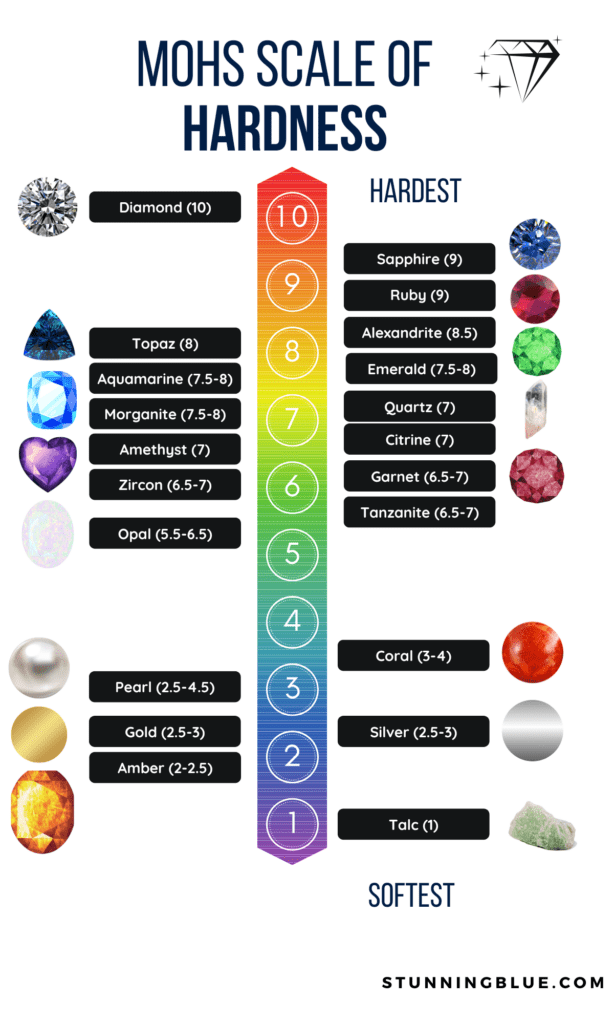The Mohs Scale, named after Friedrich Mohs who developed it in 1812, ranges from 1 (representing the softest mineral – talc) to 10 (representing the hardest mineral – diamond). Each mineral on this scale can scratch those below it and get scratched by those above it.
Whether you’re a gem enthusiast wanting to deepen your understanding, a hobbyist looking to identify your latest finds, or a student studying geology, our resources on the Mohs Scale of Hardness will equip you with the knowledge you need.
Mohs Scale of Hardness
Overview of Gemstones – Mohs Scale of Hardness
- Diamond: The diamond, with a Mohs hardness of 10, is the hardest known natural mineral. Its hardness makes it invaluable for industrial uses such as cutting, grinding, or drilling. Additionally, due to its high refractive index and dispersion, it’s highly prized in jewelry.
- Sapphire: Sapphire comes second in hardness, with a Mohs scale rating of 9. This gemstone is a variety of corundum and comes in various colors, except red. It is used in various forms of jewelry and in some types of scientific instruments.
- Ruby: Ruby, with a Mohs hardness of 9, is a red gemstone variety of corundum. It’s prized for its hardness, luster, and rarity, making it one of the highest-valued gemstones.
- Alexandrite: Alexandrite, a semi-precious gemstone, ranks at 8.5 on the Mohs hardness scale. Known for its unique ability to change color under different lighting, it’s a sought-after stone for jewelry.
- Topaz: Topaz has a Mohs hardness of 8. This gemstone can be found in a variety of colors, and its high clarity and luster make it a popular choice for jewelry.
- Emerald: Emerald, with a Mohs hardness of 7.5–8, is a variety of beryl. It has a rich green color and is often used in high-quality jewelry.
- Morganite: Morganite is another variety of beryl, with a hardness of 7.5–8 on the Mohs scale. Its pink or peach color makes it a popular choice for engagement rings.
- Aquamarine: Aquamarine, with a hardness of 7.5–8, is a blue-green beryl variety. It’s often used in jewelry and is believed to symbolize peace and tranquility.
- Quartz: Quartz, rating 7 on the Mohs scale, is a hard, crystalline mineral. It’s resistant to most physical and chemical weathering, making it an excellent component in constructing durable, lasting architecture and materials.
- Amethyst: Amethyst, a variety of quartz, has a hardness of 7. Known for its beautiful violet color, it’s used in jewelry and is often associated with spiritual clarity.
- Zircon: Zircon has a hardness of 6.5-7 on the Mohs scale. It’s found in many colors and is often used as a diamond imitation in jewelry.
- Garnet: Garnet, with a hardness of 6.5–7, comes in a variety of colors and is commonly used in jewelry and industrial applications due to its hardness and brilliance.
- Tanzanite: Tanzanite, a relatively new gemstone, has a hardness of 6.5–7. Known for its strong trichroism, its blue and violet hues make it a popular choice for jewelry.
- Opal: Opal, with a hardness of 5.5–6.5, is known for its unique play of color. Its many varieties and colors make it a favorite gemstone for jewelry.




